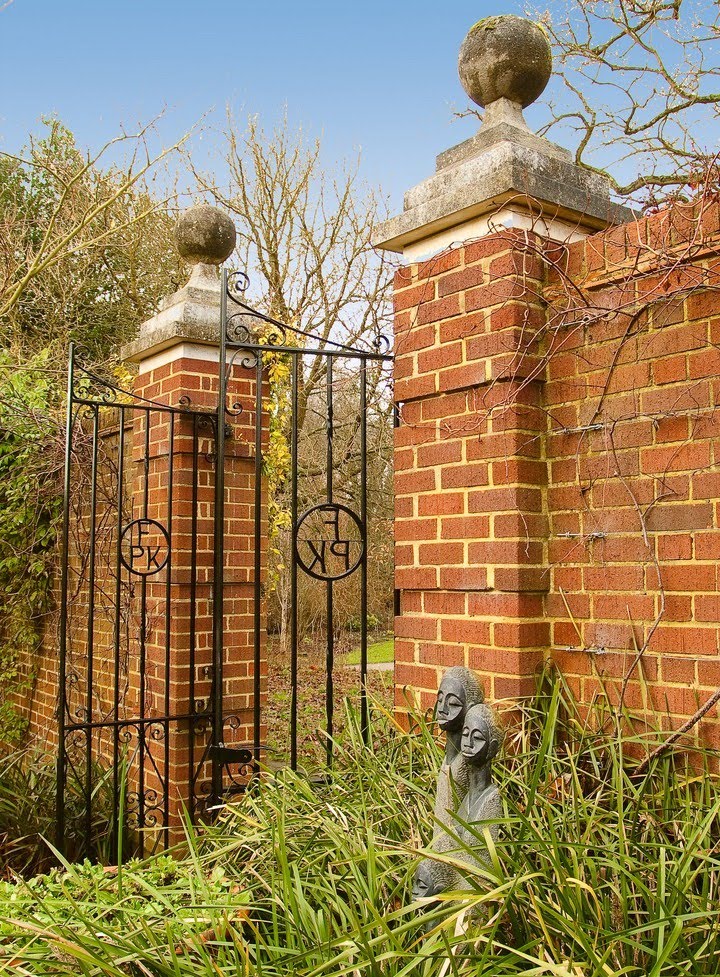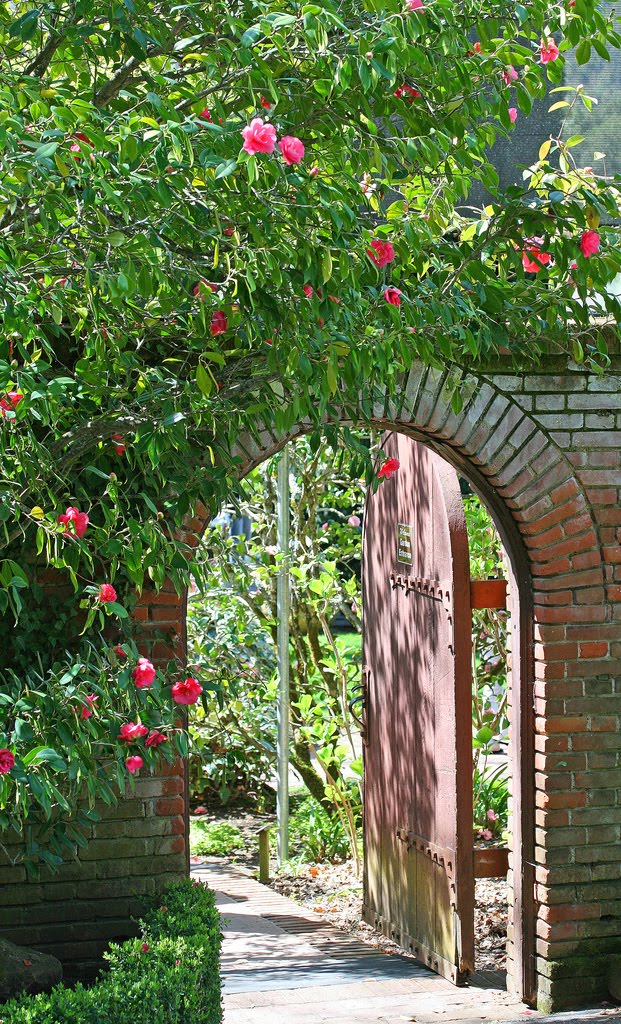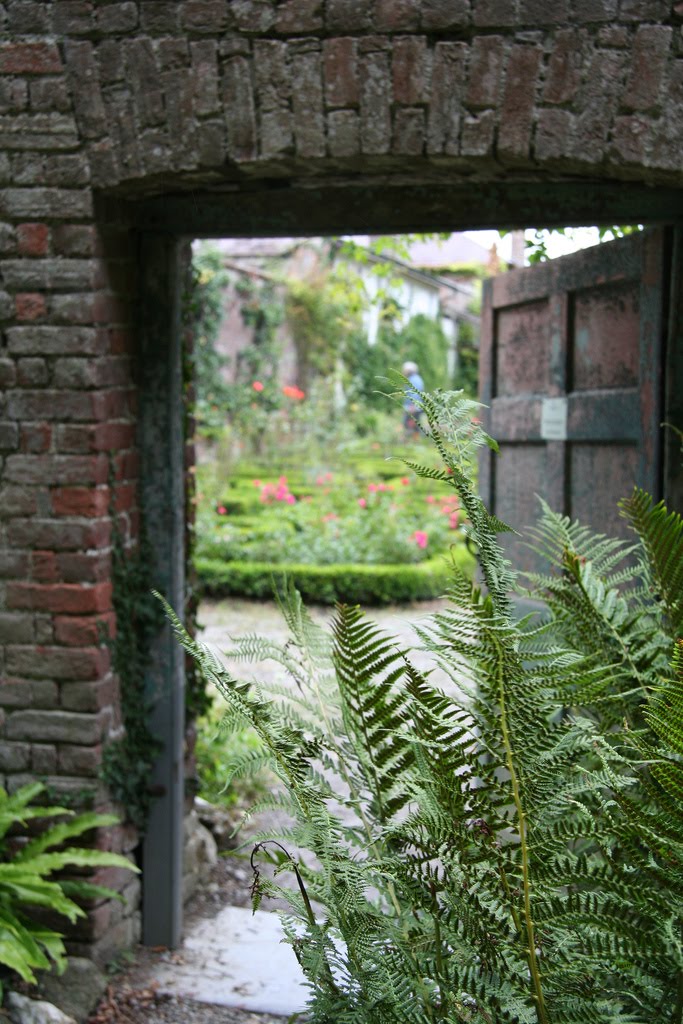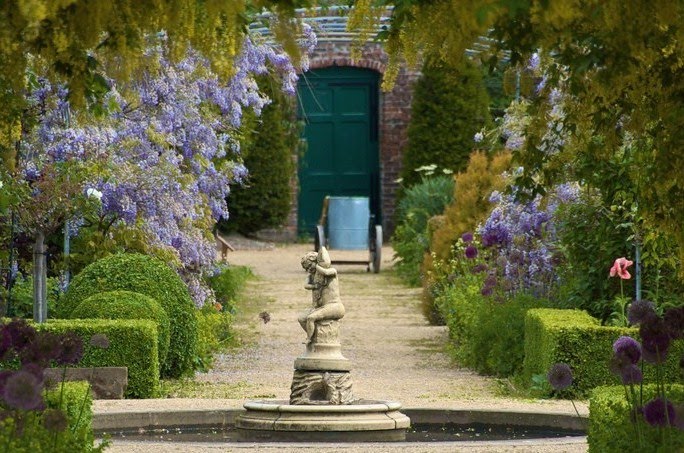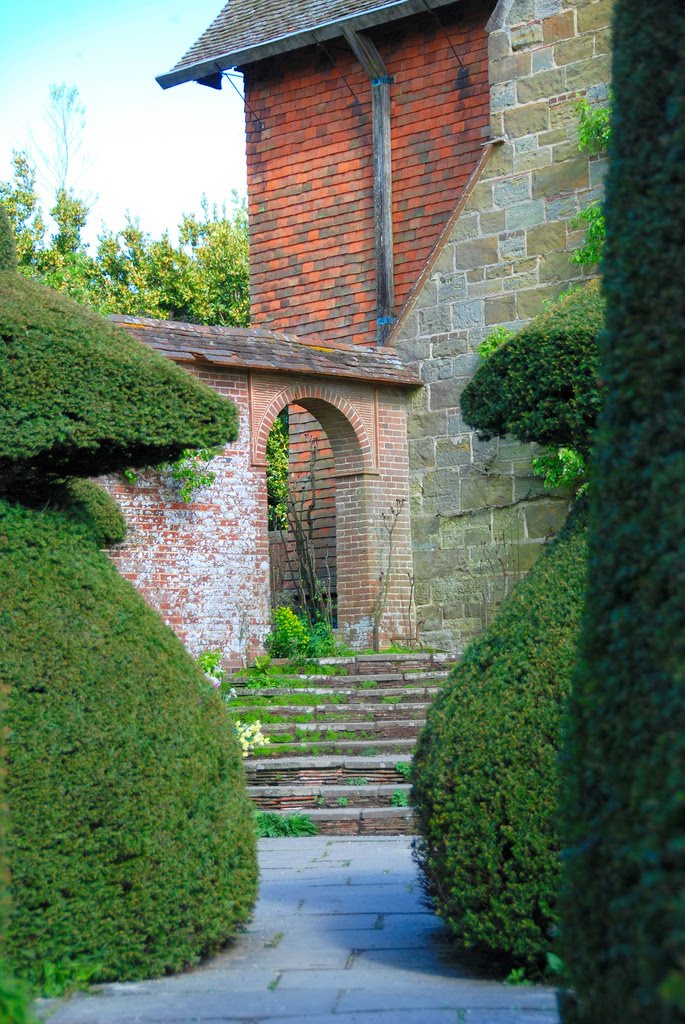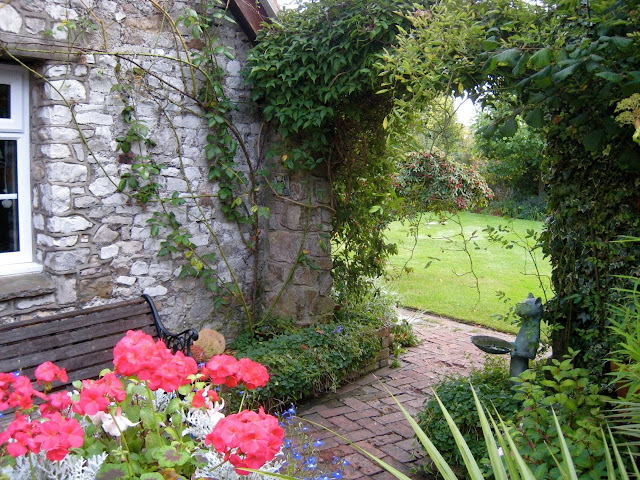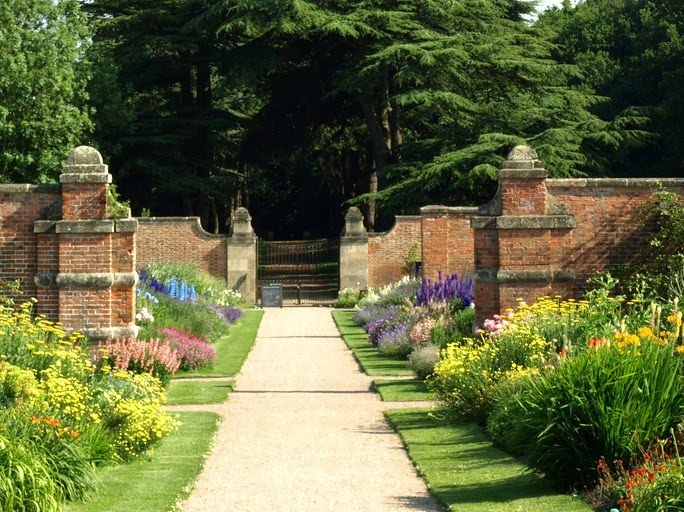George Washington’s deer park declined, while he was away serving as president. In 1792, he replaced its fence with a ha-ha or walled ditch, drawn here in black. Six years later, he planned a new course for the ha-ha, represented by the dotted line following “the natural shape of the hill.” Autograph document,
George Washington, described the ha-ha wall enclosing his deer park at Mount Vernon in October 1798, “There are two reasons for doing it in this manner—the one is, to prevent the wall from being too serpentine & crooked (as the black line)—& the second is, that the hill below the wall may be more of a sameness.—otherwise it would descend very suddenly in some places & very gradually in others.
“You will observe that this wall is not to be laid out, as worked by a line—the whole of it is serpentine, which I am particular in mentioning least by the expression in your letter of zig-zag. You had an idea that it was to be laid out by line 20 or 30 feet or yards (as the hill would admit) one way then angling & as far as it would go strait another in the following manner.” (Washington, George, October 1798, describing Mount Vernon, plantation of George Washington, Fairfax County, VA Mount Vernon Ladies Association)
“Supposing the dot at A to be the highest part of the hill in front of the House. & at the black line from B to C by A the natural shape of the hill (or fall of the hill) the pricked line may be a good direction for the wall, in order to prevent its being too serpentine or crooked—this, in some places, will come in upon the level (or that which is nearly so) of the hill—as at 1, 2, 3—& is often as at 5, 6, 7 & 8 will be below the declivity, & require filling up in order to bring the whole to a level which is to be affected by the Earth which may be taken from 1, 2, 3.— (George Washington, Drawing & Notes for a Ha-Ha Wall at Mount Vernon, October 1798, 1798.)
Edward Savage, The East Front of Mount Vernon, c. 1787–92, Detail, Mount Vernon, Virginia
A serpentine or crinkle crankle wall, also known as a crinkum crankum, sinusoidal, ribbon, or wavy wall, is a garden wall built in a serpentine shape with alternating curves, originally used in Ancient Egypt. In September 2020, upon the discovery of the "lost golden city of Luxor" in Egypt, archeologists found a distinctive "zig-zag" mudbrick wall as much as 9 feet high in some places snaking through the 3,400-year-old royal city built by Amenhotep III.
They're shaped like a snake's S-shaped slither. The alternate convex & concave curves in the wall provide stability & help it resist lateral forces, leading to greater strength than a straight wall of the same thickness of bricks.
Holbrook, Royal Hospital School in Suffolk, UK
Dutch engineers brought the concept to the England in the 1600s. Obviously well-versed in building on coastal plains, engineers from the Netherlands were hired to transform a marshy region of East Anglia, England, known as The Fens, into farmland. They created a drainage & irrigation system for the area & then surrounded it with a relatively thin, wavy brick walls they called slangenmuur, which translates in English to "snake wall."
Suffolk, UK
It was like nothing the English had seen before. The walls were also used for one specific purpose of protecting newly planted fruit trees. During the Middle Ages, it was discovered that undulating walls helped fruit trees grow better in cooler climates. The curves created pockets that protected the trees from the wind while also trapping heat from the sun and radiating it back into the trees, essentially creating a longer growing season.
An undulating wall sould help fruit trees grow better. A serpentine wall created pockets along its length which provided sheltered locations for wind-sensitive plants & would trap heat from the sun allowing longer growing seasons. Trees, mostly fruit, were planted on the south side of a wall to take advantage of reflection of heat from the mass of the masonry. Serpentine walls worked better than a straight wall for this purpose.
Tostock Place in Suffolk, UK
Around the same time, this style caught the attention of Francisco Borromini, an Italian architect & leading figure in the emergence of Roman Baroque. He used a version of serpentine wall carved into the facade, when he designed the church of San Carlo alle Quattro Fontane in Rome.
,%20or%20San%20Carlino%20Architect%20Francesco%20Borromini%20(1599-1667)%20Designed%20in%201634%20Built%20in%201682.%20Rome%20Italy30.jpg)
San Carlo alle Quattro Fontane (St Charles at the Four Fountains), or San Carlino Architect Francesco Borromini (1599-1667) Designed in 1634 Built in 1682. In Rome, Italy. Here the walls of the church itself were convex & concave in appearance which flew against the classical architecture prevalent at the time.
The term crinkle-crankle or (crinkum crankum) has its roots in old English meaning zigzag & dates back to 1598, although the term began to be applied to walls in the 16th century. The walls' unique shape makes them stand apart, both aesthetically & in practicality. The pattern of concave & convex waves, known as a sinusoidal pattern, serves a number of important purposes.
Earl Soham in Suffolk, UK
Most surviving crinkle-crankle walls are found in the boggy parts of East Anglia attributed to the influence of Dutch engineers working on draining the fen country. The Dutch name is slange muur, a snaking wall. The wavy construction allows for a strong stable & even lengthy wall with fewer bricks because it doesn’t need piers or buttresses.
Bramfield in Suffolk, UK
Another benefit is cost. While the footprint of a wavy wall is much greater than a straight one, taking up more landscape, its design helps reinforce it better than a straight wall of the same material. In other words, serpentine walls can be made a single brick layer thick, while straight walls generally require two layers. Thus, fewer materials are needed to construct a serpentine wall versus a straight one.
In early American landscape design, a wall was a masonry construction of dry laid or mortared stone or brick. While some referred to walls as a type of fence & sometimes as a “stone fence,” in Early America, wooden barriers were usually referred to as fences.
Brick Walls were well known in 17C colonial America. William Fitzhugh wrote in April 1686, describing the estate Greensprings, VA “the Plantation where I now live contains a thousand acres, grounds & fencing...a large orchard of about 2500 Apple trees most grafted, well fenced with a locust fence, which is as durable as most brick walls, a Garden, a hundred foot square, well pailed in, a Yeard wherein is most of the aforesaid necessary houses, pallizad’d in with locust Punchens which is as good as if it were walled in & more lasting than any of our bricks.” William Fitzhugh, April 1686, on Greensprings, VA (quoted in Alice B. Lockwood, Gardens of Colony & State, 2 vols. 1934)
On May 8, 1704, the Journals of the House of Burgesses of Virginia contemplated the construction in Williamsburg, VA. “Ordered. That the consideration of the proposal of the said Committee relating, [sic] to the Capitol being enclosed with a brick wall be referred til tomorrow morning. Ordered. That the Overseer appointed to inspect & oversee the building of the Capitol make a Computation what the Charges may amount to of inclosing the Capitol with a Brick Wall of two Bricks thick & four feet & a half high to be distant sixty foot from the fronts of the East & West Building & the said building & that he lay the same before the House to morrow.”
In 1706, the act of the Virginia legislature authorizing the building of the Governor's Palace allocated 635 pounds for the construction of the garden with these instructions, "that a Court-Yard, of dimensions proportionable to the said house, be laid out, levelled & encompassed with a brick wall 4 feet high with the balustrades of wood thereupon, on the said land, & that a Garden of the length of 254 foot & the breadth of 144 foot from out to out, adjoining to the said house, to be laid out & levelled & enclosed with a brick wall, 4 feet high, with ballsutrades of wood upon the said wall, & that handsome gates be made to the said court-yard & garden."
In March 0f 1760, at Mount Vernon, George Washington's plantation in Fairfax County, VA., he “Agreed to give Mr. William Triplet, 18 to build the two houses in the Front of my House (plastering them also), & running walls for Pallisades to them from the Great house & from the Great House to the Wash House & Kitchen also.”
In Maryland on January 4, 1770, The Maryland Gazette reported “The General Assembly having been pleased to grant to the Value of 7500 l. Sterling, for building a State-House...& for enlarging, repairing, & enclosing the Parade, not exceeding its present Length of 245 feet, & 160 in Breadth, designed to be enclosed with Stone or Brick Wall, & Iron Palisadoes, if the Iron Inclosure should not exceed 500 Sterling.”
In 1780-02. François Jean Marquis de Chastellux, noted that at the seat of William Byrd III, on the James River, Va “The walls of the garden & the house were covered with honey-suckles.” But he did not mention the brick walls close to the river." François Jean, (Marquis de Chastellux, Travels in North America in the Years 1780, 1781, & 1782, 2 vols. (London: G. G. J. & J. Robinson, 1787)
In 1789, Jedidiah Morse wrote of the State House Yard, Philadelphia, PA; “The state house yard, is a neat, elegant & spacious public walk, ornamented with rows of trees; but a high brick wall, which encloses it, limits the prospect.” Jedidiah Morse,The American Geography; Or, A View of the Present Situation of the United States of America(Elizabeth Town, NJ: Shepard Kollock, 1789)
On November 2, 1806, Charles Drayton, described The Woodlands, seat of William Hamilton, near Philadelphia, PA. "The Conservatory consists of a green house, & 2 hot houses-one being at each end of it. The green house may be about 50 feet long...From the Cellar one enters under the bow window & into this Screen, which is about 6 or 7 feet square. Through these, we enter a narrow area, & ascend some few Steps [close to this side of the house,] into the garden & thro the other opening we ascend a paved winding slope, which spreads as it ascends, into the yard. This sloping passage being a segment of a circle, & its two outer walls concealed by loose hedges, & by the projection of the flat roofed Screen of masonry, keeps the yard, & I believe the whole passage out of sight from the house-but certainly from the garden & park lawn." Charles Drayton, “The Diary of Charles Drayton I, 1806,” 1806, Drayton Papers, MS 0152, at Drayton Hall
In March of 1814, Charles Willson Peale wrote a letter to his sons, Benjamin Franklin Peale & Titian Ramsey Peale, describing Belfield, his estate in Germantown, PA. “The stone & ground is remooved at the Bottom of the Garden but the Wall is not as high & access into the Garden is not so easey as it used to be, even before any wall is made.”
Walls in Early America, like fences, hedges, & ha-has, usually served as barriers, supports, & markers of property boundaries. Because of their strength, walls were also used to retain earth like George Washington's 1798 deer wall at Mount Vernon.
Walls were also used to shore up banks at waterfront gardens, as at Westover in Virginia, where they served as bulkheads along the banks of the James River. In 1783, Thomas Lee Shippen, described Westover, seat of William Byrd III, on the James River, VA “the river is backed up by a wall of 4 feet high, & about 300 yards in length, & above this wall there is as you may suppose the most enchanting walk in the world.” (Thomas Lee Shippen,to His Parents in Philadelphia (Richmond, Va.: William Byrd Press, 1952)
The Horticultural Application of “Serpentine” Crinkle - Crankle Walls in Virginia
By Landon Fishburne October 1, 2020
Landon Fishburn Blog: The Thought Zoo November 21, 2020
But in his 2020 article "The Horticultural Application of 'Serpentine' Crinkle-Crankle Walls in Virginia, Landon Fishburne tells us that "According to the gardening journal, Garden History, “The object of serpentine walls was, of course, for growing fruit” (O’Neill). Referred to as “crinkle-crankle” walls in England, the serpentine wall design is a variation of fruit wall intended to increase fruit tree & plant productivity by redirecting sunlight & providing radiant heat from brick.
"The serpentine design of the wall increases surface area, allowing for more radiating material than straight walls. Gabrielle Rausse, who served as Monticello’s Director of Gardens & Grounds, explains, “the amount of material absorbing the heat in the day is greater than the amount of material you would have if the wall was a straight line. It is not the curve itself, it is the amount of bricks which are there to absorb the heat.
"Although the common, recommended height for garden walls in England was 10 feet, the applied height varied. For example, Forsyth recommended 6 to 8 foot walls as being ideal for melons. Greatly influenced by English horticultural design, Jefferson incorporated brick walls into garden designs in Virginia. The serpentine walls surrounding the pavilion gardens at the University of Virginia were added at Jefferson's persistent suggestion.
Notes from Landon Fishburne on 1799 Estate Poplar Grove in Virginia
"Several historic examples of serpentine garden walls can be found throughout Virginia dating from the late 18C century. A photo taken in 1923 shows the crumbling remains of the original serpentine wall found at Poplar Grove purchased by John Patterson in 1799 in Mathews County where, “To the west of the house, & extending almost to the water’s edge, was the old garden, & across the north end, ran a serpentine brick wall” (Historic Gardens of Virginia 161).
Notes from Landon Fishburne on 1812-20 Estate Belvidere (Belvidera) in Virginia
"A serpentine brick wall surrounded roughly 10 acres of land in Richmond, Va at Belvidere (Belvidera), an estate located on the James River purchased by Benjamin James Harris from John Harvie in 1814 (Letters of the Byrd Family. In 1820, Harris placed an advertisement in a local newspaper to rent Belividere, advertising the property as, “containing elegant buildings, with about 10 acres of Land, under a brick fence 9 feet high, with a large garden, well laid out, & a green House” (“Historical Documentation of the Site…” 24).
"In 1812, Harris wrote to Jefferson seeking advice about at least two inventions, “Fire proofe Ceilings & the other for Filtering & Refrigerating water” (Founders Online: “Benjamin James Harris to Thomas Jefferson…) Jefferson responded by providing architectural sketches as well as additional information for Harris to consider (Founders Online: “Thomas Jefferson to Benjamin James Harris…) The previous owner of Belvidere, Harvie, grew up with & was close friends with Jefferson. Harvie’s father, John Harvie, Sr, was the executor of Peter Jefferson’s estate & became guardian for the young Thomas after the death of his father (John Harvie | Thomas Jefferson’s Monticello, 2020).
"A 1848 map of Richmond shows the outline of the brick serpentine wall surrounding the property of Belvidere. (Image source Library of Virginia cited in Historical Documentation Of The Site Of Venture Richmond’s Proposed Ampitheater by Charles Pool, 2014, Richmond, Va. Available at: https://richmond.com/news/local/historical-documentation-of-the-site-of-venture-richmond-s-proposed/pdf_b533c73c-1ed8-11e3-b4f2-0019bb30f31a.html)
Notes from Landon Fishburne on 1815-1820 Estate Upper in Virginia
In 1820, a serpentine wall was also built surrounding the gardens at Upper Bremo, which was designed & built by John Hartwell Cocke with the help of John Neilson in 1820. Hand drawn sketches of the serpentine walls are included among Cocke’s personal documents & architectural drawings for the house dating from 1815. Sketch of a serpentine wall included in Cocke’s personal documents & designs for Upper Bremo (Image source: John Hartwell Cocke Letters & Papers Regarding Bremo, 1811-1865, #8453, 8453-a, Albert & Shirley Small Special Collections Library, University of Virginia, Charlottesville, Va.)
"According to Garden Club of Virginia Research Fellow, K. Brooke Whiting, there were 2 walled gardens on the property, “one primarily containing fruit & the other primarily vegetables & ornamentals”. In the gardens at Bremo, it was said that a person could walk along the serpentine wall & “feast on figs worthy of the Orient” (Historic Gardens of Virginia 136). Perhaps the figs that grew next to Bremo’s serpentine wall descended from the fig plants Jefferson sent to Cocke in 1817, including, “plants of the Marseillies fig & of the Paper or Otaheite mulberry, & cuttings of the Lombardy poplar.” (Jefferson).
"Cocke planted several varieties of figs, & other fruits, along the walls at Bremo following Forsyth’s recommendations. In his garden journals, Cocke notes that he, “Planted out two Malaga Grape Vines under the wall near East end + between two brown figs & a white fig…The other figs under the wall are the common purple” (Whiting 56). In a journal entry from October 23rd, 1818, Cocke further describes specific techniques from Forsyth’s book used to shield his figs from the arrival of the, “First killing frost. Protected fig bushes 3 days ago some sheltered & others buried according to Forsythe. The bushes now full of fruit which is daily ripening”.
"As an ardent gardener & horticulturalist, Cocke often shared plants & gardening information with his father-in-law, Dr Philip Barraud of Williamsburg, VA. On June 20th, 1820 Barraud wrote to Cocke indicating that he had built an 8 foot wall on his property (Whiting Appendix A-33). And, he often gave gardening advice regarding the horticultural applications of garden walls. When gifting grape seeds to his son-in-law, Barraud advises Cocke to, “Plant it under a wall with South Exposure” (Whiting Appendix A-28). And while boasting of his plentiful crop of winter lettuce, Barraud declares, “We have had a Salad at Table more than 9 days out of 10 since December commenced…Sow your seed in August, Septr + October + set them in warm situations under your wall + nothing bears the frost better” (Whiting Appendix A-37). It is evident that the gardeners viewed walls as being an integral part of increasing plant & food productivity, even in the winter months.
"Cocke who worked closely with Jefferson to oversee the construction of the University of Virginia while Neilson drafted an initial ground plan for the University, including serpentine brick walls throughout the University’s pavilion gardens. The cross-pollination of architectural & horticultural applications among Jefferson & his associates is evident.
Notes from Landon Fishburne on 1818 Estate Folly Farms in Virginia
"An existing serpentine wall also surrounds the garden at Folly Farms in Staunton, Va circa 1818. A Historic American Buildings Survey document by Philip Stern in 1936 states: “Joseph Smith, who built ‘Folly’ in 1818, served in the Virginia Legislature with Thomas Jefferson."
"The serpentine wall at Smith’s Folly Farms remains intact & is mostly original, aside from slight repairs made over the years. In 1923, Smith’s great-granddaughter, Annie Cochran Rawlinson, provided an account of the brick wall as well as the historical use of the garden: “An unique feature of the garden is a red-brick serpentine wall, extending around 3 sides of it. There is said to be only one other of its kind in the state, & that is the one at the University of Virginia.” (Historic Gardens of Virginia)
"Rawlinson provides of the flourishing roses & flowers grown within the garden. She states: “In the old garden roses have always flourished. Beginning with the burr rose or pink microphylla, which grew in a huge bush, the cinnamon rose, the hundred-leaf rose, the seven sisters (a climbing rose), the Persian yellow, the red Giant of Battles, the Pink daily, the Hermosa, & the Souvenir de Malmaison…The lilac & the snow-ball bushes – especially one white lilac – have grown so large, they can no longer be called anything but trees, which are about 15 feet high. Once the glory of the garden was a Persian lilac; when in bloom it was a feathery mass of rosy lavender blossoms with the most fascinating fragrance, a sight never to be forgotten! The flower border follows the graceful curves of the serpentine wall, making charming, wavy masses & sweeps of colour the entire extent of the wall. Driving up to the front gate, hollyhocks, peeping over the wall, greet one in every variety of colour. Later in the season golden-glow extends a welcome – sunflowers, hardy asters, & cosmos following in succession.” (Historic Garden of Virginia )
"The property at Folly Farms clearly shows that serpentine brick walls were being used for horticultural purposes in a Virginia home built using Jefferson-inspired architectural design prior to or at the same time the construction of the serpentine garden walls at UVa were being built.
Notes from Landon Fishburne on 1820 Hamstead in New Kent County, Virginia
"Hampstead in New Kent County was built between 1820 & 1825 by planter Conrade Webb (Hastings 36). Correspondences between Jefferson & Conrade’s grandfather, George Webb, as well as his father, Foster Webb, indicate a friendship (“Founders Online: To Thomas Jefferson From George Webb…”).
County documents reveal that at Hampstead, “a garden with serpentine walls leads to old unrestored gardens” (New Kent County Comprehensive Plan, 2002). As with Poplar Grove, the single serpentine garden wall at Homestead extends east to west providing both north-facing & south-facing surfaces, which allows for differing levels of sunlight exposure.(A single serpentine wall can be seen on the property layout at Hampstead (Image source: William T Hastings from his book “Conrade Webb of Hampstead” page 41)
Although he died before his vision was actualized, Jefferson clarified that the University’s instructional botanical garden would be divided into two sections; one section for exotic plants & one for trees. He also specified that the gardens would be surrounded by “a serpentine brick wall 7.f. high,” one foot taller than the walls surrounding the vast network of brick walls interwoven throughout the pavilion & hotel gardens at the center of the Academical Village. (Founder’s Online: From Thomas Jefferson to John Patten Emmet…”).
Notes from Landon Fishburne on 1821-23 Estate Frascati in Virginia
"In 1821-1823, James Barbour’s brother, Philip Barbour, commissioned his estate, Frascati, to be built located just 6 miles northeast of Barboursville in Somerset, VA. The estate was designed & built by John M Perry, a master builder employed by Jefferson at both Monticello & the University of Virginia, where he built serpentine walls in the university’s gardens.
Later owners of the Frascati property offer descriptions of an “orchard” located near the house. An advertisement for the sale of property in 1846, announces, “A strong Serpentine Brick Wall encloses a garden of 2 acres, in which grow, amongst other things in profusion, the finest Plums, Figs, & Grapes” (Richmond Enquirer 13 November 1846 — Virginia Chronicle).
"By 1907 the wall had been removed, as recounted by William Wallace Scott, “Until long since the war, there was a ‘serpentine’ brick wall around the garden, identical with those now at the University & at Barboursville House” (257-259). Since the garden walls at the three different locations were described as being identical, it seems likely they were similar in height as well.
Notes from Landon Fishburne on 1822 Estate Barboursville in Virginia
"Evidence of a serpentine brick wall can be found at the Barboursville estate, which Jefferson designed for James Barbour completed in 1822. According to the description of the burned ruins on the nomination form for the National Register of Historic Places, “A portion of the gardens were once surrounded by a serpentine wall similar to those designed by Mr. Jefferson for the University of Virginia” (National Registry…). In the book “Historic Gardens of Virginia,” Caroline Coleman Duke notes that Barboursville’s impressive gardens spanned nearly 3 acres & were enclosed entirely by the red serpentine brick wall. Numerous original brick & capstone remnants can still be observed strewn along the perimeter of the historic garden located down the hill from the ruins of the old Barboursville house.
"The “serpentine” crinkle-crankle wall at Barboursville was one of several built in Virigina in the early 19th century, the most famous being the walls at the University of Virginia. Since the serpentine walls are fragile & bricks were often harvested for other uses, there very well may have been more examples that have been lost & forgotten over the years without historical record. Amazingly, physical evidence currently still exists on the grounds at Barboursville to support the magnificent historical descriptions of the serpentine walls that once existed there.
"A description of the historic 3-acre serpentine, brick-walled gardens at Barboursville is provided in the book, Historic Gardens of Virginia, printed in 1923. Caroline Coleman Duke describes: The original garden covered nearly three acres, & was entirely surrounded by the serpentine wall of red brick…The design of this old garden is in formal squares, which are separated from each other by wide grass-covered walks. Each square is deeply bordered with flowers & the inside filled with small vegetables. A bold stream, along whose banks were naturalized daffodils, narcissi, & forget-me-nots, runs through the garden; &, at intervals, this was spanned by three rustic bridges. In the borders were all kinds of old-fashioned flowers of that day, & its many varieties of peonies were known far & wide. The serpentine wall was covered with English ivy, & its curves were violets & lilies of the valley. There was a huge cherry tree in the center of the garden from which radiated the rose arbors. There were avenues of lilac & other shrubs, with blossom or decorative berry for each month of the year, as well as sunny corner of sweet herbs, as essential to the excellence of old gardens as old cooks. With Thomas Jefferson, James Madison, & other distinguished neighbors, the garden at Barboursville was not infrequently the scene of merriment; nor did they need the local moonshine to give snap & sparkle to these occasions, for the cellars near by were amply stocked with imported liquors, & mint flourished in every nook & cranny, so no guest ever left Barboursville without at least one sip of the favorite beverage of old Virginians. (Historic Gardens & Brick Remnants From Old Serpentine Wall at Barboursville By Landon Fishburn Blog: The Thought Zoo November 21, 2020)
SerpentineWall at the University of Virginia
Notes from Landon Fishburne on Jefferson proposing Serpentine Walls for UVA
Thomas Jefferson, Third variant for range & gardens, showing serpentine walls at the University of Virginia, c. 1817-22, Thomas Jefferson Special Collections Library, UVA
Adams, Herbert B. Thomas Jefferson & the University of Virginia. Washington, D.C.: Government Printing Office, 1888. U.S. Bureau of Education Circular of Information No. 1.
Bruce, Philip A. History of the University of Virginia, 1819-1919: The Lengthened Shadow of One Man. Volume 1. New York: Macmillan Co., 1920.
Cabell, Nathaniel F., ed. Early History of the University of Virginia. Richmond, Va.: J. W. Randolph, 1856.
Grizzard, Jr., Frank E. “Documentary History of the Construction of the Buildings at the University of Virginia, 1817-1829.” PhD diss., University of Virginia, 1996.
Jefferson, Thomas, Architectural Drawings for The University of Virginia. Third variant for range & gardens, showing serpentine walls at the University of Virginia, c. 1817-22. Thomas Jefferson Papers (N369r), Albert & Shirley Small Special Collections Library, University of Virginia, Charlottesville.
O’Neal, William B. “The Workmen at the University of Virginia, 1817-1826: With Notes & Documents.” Magazine of Albemarle County History 17 (1958-1959): 5-48.
O’Neill, Jean. “Walls in Half-Circles & Serpentine Walls.” Garden History, vol. 8, no. 3, 1980, pp. 69–76. JSTOR, https://doi.org/10.2307/1586736.
Siegel, Oren. “The Development & Function of Serpentine/Sinusoidal Walls.” Journal of the American Research Center in Egypt, vol. 52, 2016, pp. 53–89.
Waite, John G. Associates, Architects. The Rotunda: University of Virginia Historic Structure Report. Albany, NY: John G. Waite Associates, Architects, 2008.
Wilson, Richard G., ed. Thomas Jefferson’s Academical Village: The Creation of an Architectural Masterpiece. Rev. ed. Charlottesville & London: University of Virginia Press, 2009.
.jpg)
%20Virgin%20with%20Child%20at%20Sunset.jpg)

.jpg)



,%20or%20San%20Carlino%20Architect%20Francesco%20Borromini%20(1599-1667)%20Designed%20in%201634%20Built%20in%201682.%20Rome%20Italy30.jpg)










